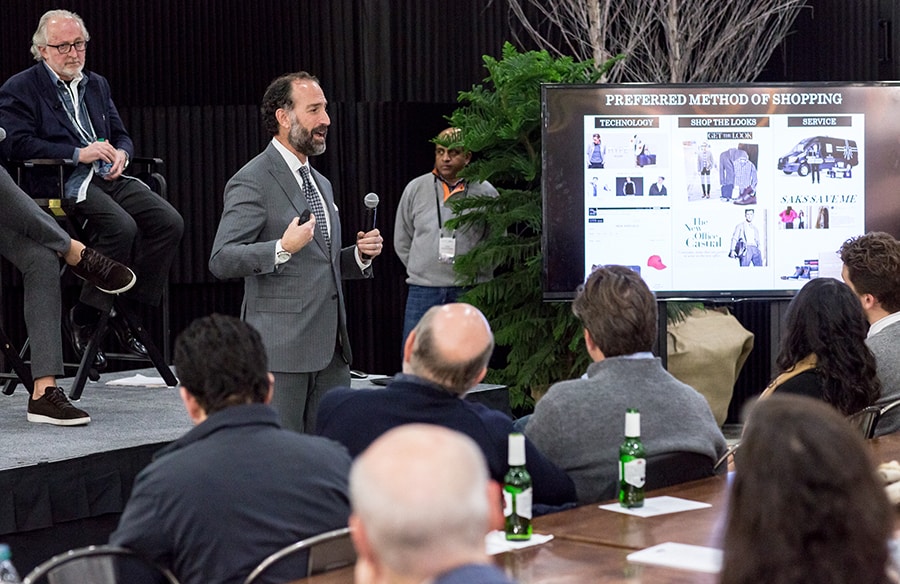ANSWERING THE QUESTION: RETAIL REALITY, WHAT NOW?


Robin Lewis, a menswear veteran and founder and CEO of The Robin Report, began by telling the audience that men’s retailers were facing a “tsunami” and those who wanted to survive needed to move as fast as possible, since the “tsunami” could wipe out every old world retailer. He said the issues went beyond the prevalence of e-commerce, pointing out that stores were currently overstocked and overstocked. He pointed out that as demand for product slows down, stores were resorting to insane promotions and opening too many outlet stores, both of which he said led to deflation of prices and profits.
Lewis also talked about how retailers must deal with the next big consumer segment: millennials. “They don’t want to go to big buildings full of stuff, and they don’t really want or need more stuff,” he said. “They prefer experiences.” He went on to explain that smart retailers are focusing on innovation, including better use of data, increased personalization, digital pay and other issues that could help differentiate them from the competition.
He also noted that stores need to make themselves “cool,” which includes buying exclusive brands, adding more private label and leasing part of their space to concessions and pop-up shops. Expanding on the topic, he said stores would have to “flip” their vision and take their lead from the entertainment and hospitality business. “The real question they have to answer,” he said “is what can they do to get people to come back to their stores over and over again? They need to become a place where people can socialize, become educated, and get personal advice and service.”

According to research Saks is using, millennials favor mobile offers and mobile devices over formerly traditional media (i.e. magazines) and rely strongly on word of mouth, especially from so-called “influencers.” (He pointed to the success of a recent collaboration with NBA star Anthony Davis on a capsule collection.” Ott also noted that younger customers were as interested in “shopping a look” as they were in sticking to any one brand, favor brands that are all about “fashion” and newness.
Nonetheless, Ott stressed that customers of all ages truly value great service and experiences, telling the audience that Saks new store at New York’s Brookfield Place (which will open next month) will include an apothecary, barber shop, shoe-shine station, and Fika coffee bar, among other amenities. “Consumers need to be delighted, not disappointed,” he said.
Ott also refuted any claim that the proliferation of Saks off-price store, Saks OFF 5th, was hurting its primary store business. “We carry the product first and they carry it second. It’s really a complimentary business,” he said.
Bob Mitchell, co-CEO of the Mitchell Family of Stores (which now number eight specialty stores around the country), said his customers –which still trend toward baby boomers – are happiest when technology is integrated with an exciting in-store experience. “And what really keep people coming back to our stores are great people,” said Mitchell. He spoke of making sure Mitchells’ sales staff act as style advisors, both in-store and online, and also pointed out that men are looking for such service innovations as the ability to reserve product online to see and try on in-store, as well as virtual closerts where men can keep track of all their previous purchases.

As to whether the concept of luxury remains important to consumers, Mitchell was steadfast. “I still believe that as long as wealth exists, people will want luxury goods. My idea of luxury, however, is something that makes the customer feel special, something to which they have an emotional connection, and which they can afford. It can cost $25 or it can cost $5,000. And the important thing is that we need to educate our younger clients about the importance of luxury.”
The final speaker on the panel was Simon Graj, founder and CEO of influential branding agency Graj+Gustavsen. He also spoke about the importance of focusing on the millennial customers, stating that the younger generations prefers to buy from brands that have a strong purpose or “make money while also doing good.” He also added that they would not be seduced by brands that send out a “fake message.” He also stressed that brands that do not cost a lot (such as Uniqlo) or have discovered successful disruptive models (such as Harry’s) are likely to be those that survive.
“This is the best marketplace of entrepreneurial opportunity I’ve ever seen,” he stated. “I am more inspired than ever before.”


Even back in the late 60’s and 70’s when I was a buyer for an amazing iconic better men’s specialty store called, Schlesingers, in West New York New Jersey, I bought for a department of trendy sportswear as well as denim… Case and point to all your comments above, a great new innovative designer just starting out named Willie Smith, created sport coats in cotton with no linings… I was the first store in New Jersey to give Willie a huge part of my departments space to present his brilliant concept… We had a great run, but as he began to grow and his brand began showing up everywhere, I dropped his collection and began to look for the next new trending designer… Yea, I lost some business, however, it was then an overly divided business.. I then found a women who brought to NY’s Greenwich Villiage Italian Premium Jeans called Fiorucci… When I met Maria Gratzia in her grand opening evening, we hit it off amazingly, and she aloud me to sell in my department Fiorucci Premium Jeans @48.00 retail…!! Mr. S had a fit until he saw my selling numbers… I was the first store in New Jersey to sell Premium Jeans with no tax… (Still no tax on clothing in New Jersey, thanks to Sid Schlesinger, my boss) My point here to all the better stores, support your innovative and creative designers out there and your survival will be a none issue…. Trust me, your customers will always look forward to shopping your stores excited to discover the next new design they cannot live without….
I attended the panel discussion…great job…so insightful!!